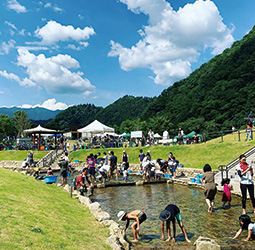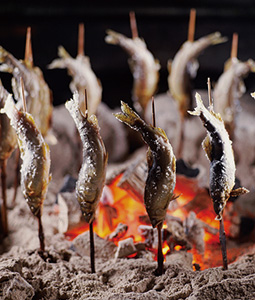INDEX

Ayu sweetfish, a symbol of the Nagara River 
Ukai cormorant fishing on the Nagara River 
The GIAHS Nagara River Ayu Park in Gujo City, Gifu Prefecture, where visitors can enjoy catching and eating ayu 
Salt-coated ayu grilled the traditional way over charcoal
- PREVIOUS
- NEXT
July 2021
Ayu of the Nagara River System

The Nagara River and the ayu sweetfish which thrive in its clear waters have been protected by local people for generations. In 2015, in recognition of these efforts and related traditions, “Ayu of the Nagara River System, Japan” was designated as a Globally Important Agricultural Heritage System (GIAHS) by the Food and Agriculture Organization (FAO) of the United Nations.

The 166-km-long Nagara River flows from its source on Dainichigatake, a mountain in northwestern Gifu Prefecture, through Gujo, Mino, Seki, Gifu and other cities in Gifu Prefecture before emptying into the Pacific Ocean off Ise Bay in Mie Prefecture.
The symbol of the Nagara River is the ayu sweetfish (Plecoglossus altivelis), a river fish known as the Queen of the Clear Waters. Wild ayu grow by eating nutritious algae that accumulate on rocks at the bottom of the river.
People eat small young ayu deep fried as tempura while adult ayu are often grilled with salt. The adult fish has a unique bitterness and a watermelon-like mellow aroma. On account of this fine aroma, which is not found in other fish, since ancient times ayu has been called kogyo, which means “aromatic fish.”

The Nagara River is rich in biodiversity. In addition to ayu, approximately 100 species of fish live in the river, including the red-spotted masu salmon (Oncorhynchus masou ishikawae), as well as the Japanese giant salamander, a Special Natural Monument, one of the world’s largest amphibians.
A variety of traditional fishing methods to catch ayu have been passed down along the Nagara River.
For example, ukai is a method of catching ayu with over 1,300 years of history that ingeniously makes use of tethered cormorants to catch the fish.

Sebari ami ryo is a method for catching ayu in a static state with a cast net. A strip of white cloth or vinyl is laid out at the bottom of the river above which a rope is stretched across the surface of the water. Gravid ayu swimming down the river to spawn from around October are surprised by the sound of the rope hitting the water and stop swimming.
Another method is yoami ryo (nighttime net fishing), in which ayu are caught at night after being driven by the sounds of paddles hitting the water’s surface and by the light of bonfires on the boats.
Inoue Akane from the Satokawa* Promotion Division, Department of Agricultural Policy of the Gifu Prefectural Government, explains some of the ways in which the Nagara River and ayu are utilized.

“In addition to tempura and salt-grilled ayu, there is also ayu sushi and Japanese-style sweets made into the shape of ayu. Without a doubt, ayu from the Nagara River are synonymous with the food culture of Gifu. There are also many traditional satokawa crafts in the regions along the river that are deeply connected with the waters, including Honminoshi (high-quality handmade paper), which is listed on the UNESCO Representative List of the Intangible Cultural Heritage of Humanity.”
In this way, the Nagara River and ayu are deeply connected to the traditional foods and culture of the river basin, and the people here have taken good care of this nature and their traditions for generations. This led to their recognition as a Globally Important Agricultural Heritage System (GIAHS) in 2015, with the official title of “Ayu of the Nagara River System, Japan—The Connection Between Ayu and the People of the Satokawa.”
Inoue says, “The river was recognized as a GIAHS because the unique Nagara River system in which the ayu, its clear waters, efforts to protect these waters, the preservation of the forests that add nutrients to the river at its source, the fishing industry, and traditional culture are all connected, continues to function well.
This is why the people along the river have not only enjoyed its benefits, but have also continued a variety of efforts to protect the natural river environment.”

For example, a tree-planting project at the river’s source is progressing through the cooperation of fishers, foresters and local residents. The local governments are also expanding designated fish-breeding forests, where tree felling and other activities are restricted to support the habitation and breeding of fish. This forest preservation controls soil and tree runoff into the Nagara River, and prevents the water quality from deteriorating. Local governments in the river basin also monitor water quality, and local companies and residents participate in river cleanup activities, as well. Thanks to these efforts that involve various individuals and organizations, the clear waters of the river and its biodiversity are protected, while as many as 860,000 people live in the river basin. And because this environment is maintained, the local traditions and culture are also protected.
To pass on the clear waters of the Nagara River to the next generation, a variety of individuals and organizations will continue to work together and manage the Nagara River.
* Satokawa is a river that enriches the lives of people in the basin through proper management.
- PREVIOUS
- NEXT

